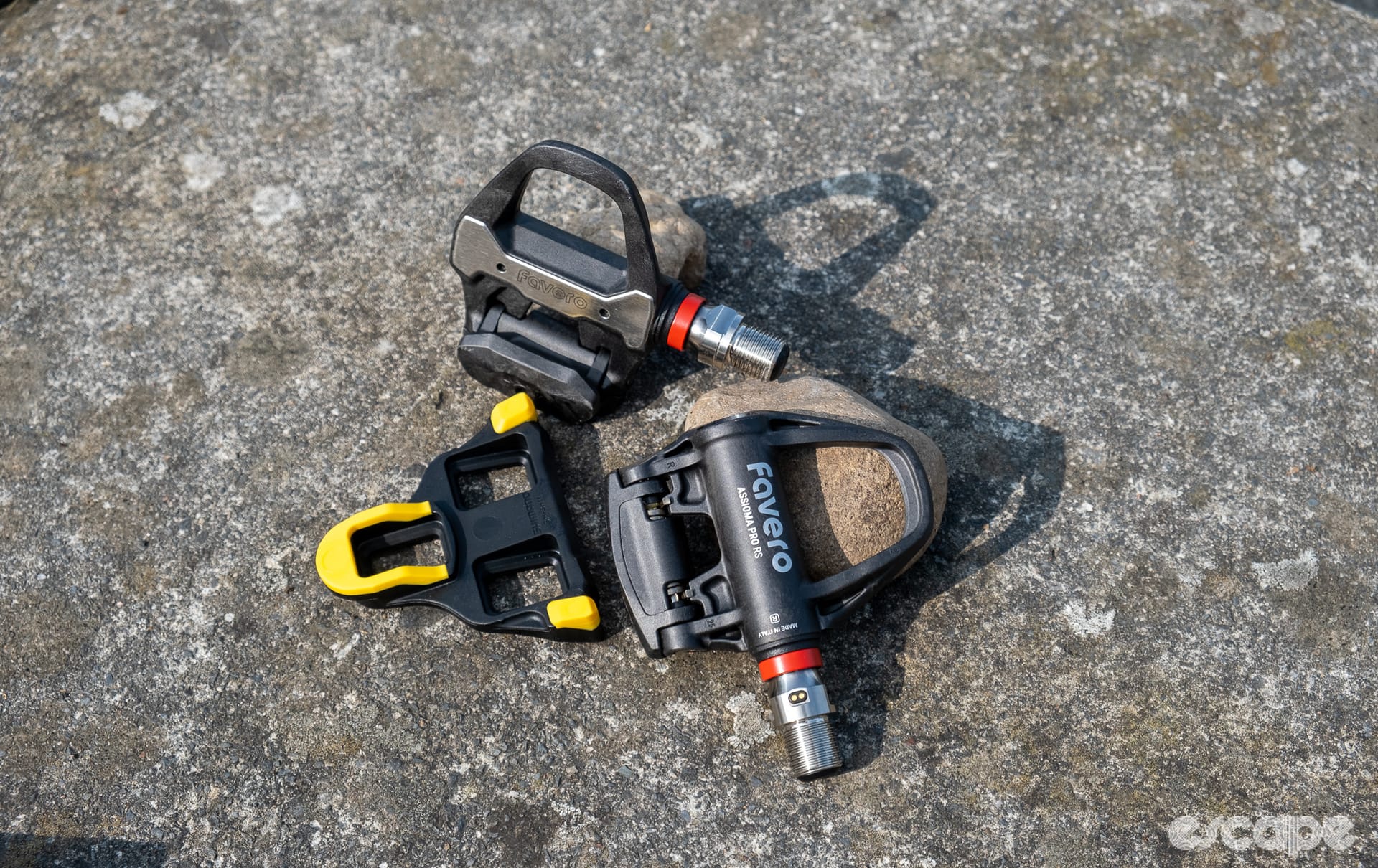The Favero Assioma PRO RS (SPD-SL) represents the latest evolution in Shimano®-compatible power pedals from Favero, building upon the solid foundation of the earlier Assioma DUO-Shi. This comprehensive comparison breaks down the key differences between these two power meter systems to help you make an informed decision.
1. Q-Factor and Ergonomics: A Narrower Stance
One of the most significant improvements in the PRO RS is the reduced Q-factor:
- Assioma PRO RS: +53 mm Q-factor closely matches standard Shimano® road pedals
- Assioma DUO-Shi: +64/65 mm Q-factor (depending on pedal body used)
This 11-12 mm difference is substantial for riders sensitive to stance width changes. The PRO RS maintains your established bike fit without requiring adjustments to saddle position or cleat placement.
2. Weight: Lighter and More Efficient
The PRO RS achieves impressive weight savings:
- PRO RS: 123.5g per pedal with integrated power sensor
- DUO-Shi: 157g per side when fitted with Shimano Ultegra R8000 pedal body
At just 10.5mm stack height, the PRO RS ranks among the lightest power-meter road pedals available, reducing rotational mass where it matters most.
3. Extended Battery Life
Power management sees notable improvement:
- PRO RS: >60 hours of continuous use per charge
- DUO-Shi: ~50 hours under normal conditions
Both systems feature magnetic charging (USB-C for PRO RS, micro-USB for DUO-Shi), but the PRO RS’s 20% longer battery life means fewer charging interruptions during training blocks.
4. Advanced Cycling Dynamics
While both systems offer Favero’s IAV Cycling Dynamics, the PRO RS takes it further:
PRO RS Features:
- Platform Center Offset (PCO)
- Power Phase (PP) start/end tracking
- Power Phase Peak (PPP)
- Torque Effectiveness (TE)
- Pedal Smoothness (PS)
- Rider Position detection (seated vs. standing)
- Enhanced gyroscope placement for improved accuracy during sprints and high-torque efforts
The DUO-Shi offers similar metrics but with less optimized gyroscope placement, potentially affecting data quality during irregular pedaling patterns.
5. Installation: Plug-and-Play vs DIY
This is where the systems differ most dramatically:
PRO RS:
- Complete pedal set ready to install
- Includes Shimano® SM-SH10/11/12 cleats
- Standard pedal installation process
DUO-Shi:
- Requires separate Shimano® pedal bodies (PD-R8000, R7000, 6800, R550, R540)
- DIY spindle swapping process
- Additional cost for pedal bodies ($80-120 USD / €80-120)
6. Connectivity and Compatibility
Both systems support ANT+ and Bluetooth, but the PRO RS offers:
- Unlimited ANT+ connections
- Up to 3 concurrent Bluetooth devices
- Improved firmware stability
The DUO-Shi’s earlier firmware sometimes limited Bluetooth connections to one device at a time.
Current Pricing
| Model | USD Price | EUR Price | AUD Price | Additional Costs |
|---|---|---|---|---|
| PRO RS-2 (Dual) | $789 | €578 + VAT | $1,299 | None (complete system) |
| PRO RS-1 (Single) | $499 | €363 + VAT | $849 | None (complete system) |
| DUO-Shi | ~$589 | ~€589 | ~$899 | $80-120 / €80-120 (pedal bodies) |
Technical Specifications Summary
| Specification | PRO RS | DUO-Shi |
|---|---|---|
| Q-Factor | +53mm | +64/65mm |
| Weight per pedal | 123.5g | 157g (with R8000) |
| Battery life | ≥60 hours | ~50 hours |
| Stack height | 10.5mm | Shimano standard |
| Accuracy | ±1% | ±1% |
| Installation | Plug-and-play | DIY assembly |
Value Analysis
When comparing total cost of ownership, the PRO RS presents compelling value:
- PRO RS-2 Dual: $789 USD complete system
- DUO-Shi Total Cost: ~$589 + $80-120 (pedal bodies) = $669-709 USD
For approximately $80-120 more than a complete DUO-Shi setup, you get significant improvements in Q-factor, weight, battery life, and installation convenience with the PRO RS-2.
The Verdict
The Assioma PRO RS represents a significant evolution over the DUO-Shi, addressing key pain points while maintaining Favero’s renowned accuracy and reliability. The narrower Q-factor alone makes it a compelling upgrade for riders who want power measurement without compromising their established bike fit.
Key advantages of the PRO RS:
- Better bike fit compatibility with standard Shimano geometry
- Lighter weight for improved pedaling efficiency
- Longer battery life for extended training sessions
- Simplified installation with complete pedal system
- Enhanced data quality from improved sensor placement
While the DUO-Shi remains a capable power meter, the PRO RS offers meaningful improvements across nearly every metric. When factoring in the required pedal bodies for the DUO-Shi system, the price difference becomes minimal while the benefits are substantial.
For cyclists seeking accurate power measurement with minimal compromise to their existing setup, the Favero Assioma PRO RS (SPD-SL) stands as the clear choice in the current Shimano-compatible power pedal market.




Great comparison! I’ve been using the DUO-Shi for about 18 months and that Q-factor difference is real – it took me weeks to adjust my bike fit when I first got them. The PRO RS sounds like exactly what I need for my next upgrade. The plug-and-play installation alone would save me so much hassle.
The weight savings alone justify the upgrade for me. 34g per pedal might not sound like much, but when you’re climbing 8% grades for hours, every gram counts. Plus that 60-hour battery life is a game changer – I’m tired of my current power meter dying mid-ride. Thanks for the detailed breakdown!
This is exactly the kind of detailed analysis I was looking for! I’m a triathlete and the cycling dynamics features on the PRO RS sound incredible – especially the torque effectiveness and pedal smoothness metrics. The fact that it’s actually cheaper than the DUO-Shi (when you factor in pedal bodies) makes this a no-brainer. Ordering mine today!
As a bike shop owner, I can confirm this analysis is spot on. We’ve installed dozens of both systems and the PRO RS is significantly easier to work with. The Q-factor issue with DUO-Shi caused fit problems for about 30% of our customers. Also worth noting – the PRO RS warranty support has been excellent in our experience. Great write-up!